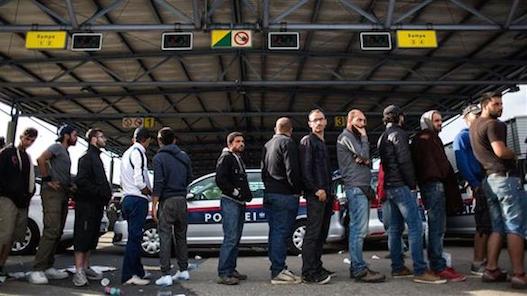

Copyright AFP
Incidents in Macedonia occurred following the decision of countries along the Western Balkans route from 17 November to only allow in the asylum seekers fleeing from Syria, Afghanistan and Iraq. This rule was initially adopted by Slovenian authorities and as a chain reaction followed in Croatia, Serbia and Macedonia. As a result, thousands of people from Morocco, Sri Lanka, Iran, Somalia, Sudan, Pakistan and other countries remained stranded across the borders.
Countries’ reasoning to limit the intake of asylum seekers was backed up with justification that atrocities are affecting only asylum seekers that are fleeing from on-going conflicts, whereas people from other countries can be classified as economic migrants. This dangerous and misleading wordplay has already brought into question the existence of 1951 Geneva Convention and the entire asylum protection system. Labelling people as economic migrants means a priori excluding them from asylum procedure and individual processing. The situation is particularly distressing in the context of developments in the second quarter of 2015 when 330 asylum seekers from Sri Lanka, 865 from Sudan, 540 from Somalia, 1, 190 from Iran, and 335 from Pakistan have obtained refugee status in the EU due to persecution they faced in their home countries, thus confirming that under no ground can any of these countries be defined as safe.
The asylum system has taken another toll by the EU-Turkey deal. In October, Turkey was offered an assistance package of 1 billion EUR followed by a prospect of visa liberalisation. Two months later, Turkey utilized its strong bargaining position of being the gateway for asylum seekers to Europe and secured 3 billion EUR of aid, an opening of a new Chapter in the accession negotiation process which has been at a stalemate for a decade, as well as promise of a visa liberalization by October 2016.
In return, Turkey has an obligation to act as an impenetrable barrier to migrants from reaching the European soil and simultaneously to improve the living conditions of over 2,2 million Syrian asylum seekers currently residing within its borders. To understand the magnitude of this task, it should be noted that while in 2015, less than 1 million of asylum seekers have managed to cause a havoc on a Union of 28 states the population of which is over 500 million, the EU now expects a single country of 70 million people to adequately provide for a double number of asylum seekers. All this in spite of the fact that the Turkish authorities have failed to do so since 2011.
What is particularly striking is that though Turkey is a signatory to the Geneva Convention, the country imposed geographic limitation to the validity of the Convention and recognizes as refugees only persons that are fleeing from European countries. In practice this means that people fleeing from the Middle East are not eligible for international protection. They are only given temporary protection and the UNHCR is in charge for processing of claims and resettlement. Though Turkey improved its asylum legislation since 2013, the overall conditions remain poor and the country’s track record in human rights abuses and frequent imprisonment hardly make it a desirable environment for protection. In spite of all of this and to justify the agreement, the EU will be ready to enlist Turkey as a safe third country, and potentially even as a safe country of origin.
Offering economic and political incentives to third countries as a method of dealing with unwanted influx of asylum seekers is not a novel practice. Australia was heavily criticized in the international community for its practice of off-shore processing of asylum seekers in Indonesia, Papua New Guinea and Nauru and for subjecting people to inhumane treatment.
The EU, on the other hand, has prided itself for developing fair and transparent asylum procedures since the early 2000s’ and for improving the conditions for the reception of asylum seekers. These measures are enshrined in the asylum directives that constitute the core of Common European Asylum System that was supposed to become operational this summer.
The notion of fair asylum policies were quashed in 20115 with the erection of border fences, excessive use of police force against migrants, including repeated use of paper spray and rubber bullets, all underscored with a prevailing line of reasoning that the solution should be sought in tightening of borders. Political leaders see the way out of crisis in increasing border control in order to keep asylum seekers in the transit countries or the countries of origin, regardless of the human rights abuses they might experience.
Throughout the crisis major EU summits were concentrated on striking a deal with third parties – whether with the countries along the Western Balkan route in September, with African countries through the creation of the Emergency trust fund in return for attempts to curb emigration in November, or with Turkey in the past two months. The only decision that had a human rights dimension and implied internal problem solving was an agreement struck on EU meeting of Ministers of interior on 25 September on the relocation of 160,000 asylum seekers from Greece and Italy. Still, it was met with harsh criticism of significant number of the Union member states. As a result of this agreement, two months later, out of 160,000 people, total of 159 people have been relocated.
The events of the past weekend mirror the developments of the EU asylum crisis for the past six months and the continuous shutdown of borders. The unwillingness to seek a solution that would take into account responsibility of the EU member states under the international law and its own national asylum procedures, has led to further borders’ securitization, leaving the asylum seekers stranded on their road to safety and back into the conditions they are trying to escape from.